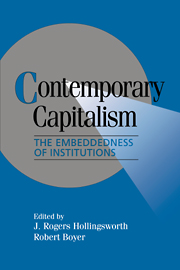Book contents
- Frontmatter
- Contents
- Acknowledgments
- List of Contributors
- Chapter 1 Coordination of Economic Actors and Social Systems of Production
- PART I THE VARIETY OF INSTITUTIONAL ARRANGEMENTS AND THEIR COMPLEMENTARITY IN MODERN ECONOMIES
- PART II HOW AND WHY DO SOCIAL SYSTEMS OF PRODUCTION CHANGE?
- PART III LEVELS OF SPATIAL COORDINATION AND THE EMBEDDEDNESS OF INSTITUTIONS
- Chapter 10 Perspectives on Globalization and Economic Coordination
- Chapter 11 Globalization in Question: International Economic Relations and Forms of Public Governance
- Chapter 12 Clubs are Trump: The Formation of International Regimes in the Absence of a Hegemon
- Chapter 13 The Emerging Europolity and Its Impact upon National Systems of Production
- PART IV CONCLUSION
- Index
Chapter 10 - Perspectives on Globalization and Economic Coordination
Published online by Cambridge University Press: 05 June 2012
- Frontmatter
- Contents
- Acknowledgments
- List of Contributors
- Chapter 1 Coordination of Economic Actors and Social Systems of Production
- PART I THE VARIETY OF INSTITUTIONAL ARRANGEMENTS AND THEIR COMPLEMENTARITY IN MODERN ECONOMIES
- PART II HOW AND WHY DO SOCIAL SYSTEMS OF PRODUCTION CHANGE?
- PART III LEVELS OF SPATIAL COORDINATION AND THE EMBEDDEDNESS OF INSTITUTIONS
- Chapter 10 Perspectives on Globalization and Economic Coordination
- Chapter 11 Globalization in Question: International Economic Relations and Forms of Public Governance
- Chapter 12 Clubs are Trump: The Formation of International Regimes in the Absence of a Hegemon
- Chapter 13 The Emerging Europolity and Its Impact upon National Systems of Production
- PART IV CONCLUSION
- Index
Summary
In the opening chapter of this book, Hollingsworth and Boyer suggest that “we must be sensitive to how economic coordination is linked to all spatial-territorial areas – the level of regions within countries, the level of the nation-state, and levels beyond the nation-state.” The process of globalization discussed in this chapter creates a need for improved economic coordination at the transnational level, yet it is at that level that it is particularly poorly developed and difficult to achieve. The development of economic globalization has not been counterbalanced by the development of appropriate mechanisms of governance.
The 1980s have seen an accelerating process of economic globalization, but a relatively limited development of political structures that can regulate this process. Indeed, the best developed mechanisms of governance that exist at the supranational level are intra- and interfirm: coordination within the new “stateless firms” discussed in this paper, and between firms through such devices as joint ventures and cartels. The chief executives of stateless firms claim with some justification that their enterprises “change relations between companies. We function as a lubricant for worldwide economic integration” (Taylor, 1991: 105). However, firms are not well placed to act as agents of international governance, particularly if the insertion of public policy objectives in the decision-making process is thought to be desirable. International firms create the need for improved international governance, but they do not and cannot provide it.
- Type
- Chapter
- Information
- Contemporary CapitalismThe Embeddedness of Institutions, pp. 319 - 336Publisher: Cambridge University PressPrint publication year: 1997
- 5
- Cited by



